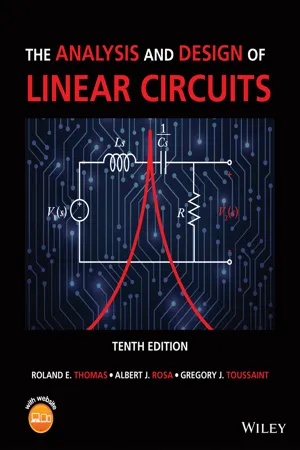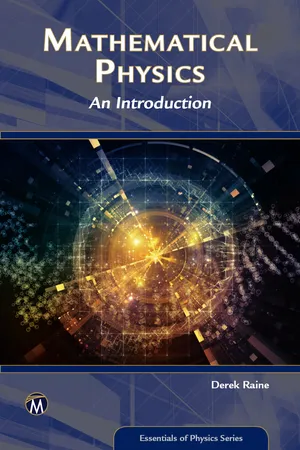Technology & Engineering
Fourier Series Symmetry
Fourier Series Symmetry refers to the property of a Fourier series that allows for simplification of the series by taking advantage of the symmetry of the function being analyzed. This can lead to a more efficient and accurate representation of the function.
Written by Perlego with AI-assistance
Related key terms
Related key terms
1 of 4
Related key terms
1 of 3
3 Key excerpts on "Fourier Series Symmetry"
- eBook - ePub
- Roland E. Thomas, Albert J. Rosa, Gregory J. Toussaint(Authors)
- 2023(Publication Date)
- Wiley(Publisher)
t = 0 vertical axis is located at a local maximum. If the axis is shifted to a zero crossing, the waveform has odd symmetry and the cosine terms in the series are replaced by sine terms. If the vertical axis is shifted to a point between a zero cross and a maximum, then the resulting waveform is neither even nor odd and its Fourier series contains both sine and cosine terms.EXAMPLE 13–5
Given that f(t) is a square wave of amplitude A and period T0 , use the Fourier coefficients in Figure 13–4 to find the Fourier coefficients of g(t) = f(t + T0 /4).SOLUTION:Figure 13–7 compares the square waves f(t) and g(t) = f(t + T0 /4). The square wave f(t) has odd symmetry (sine terms only) and half-wave symmetry (odd harmonics only). Using the coefficients in Figure 13–4 , the Fourier series for f(t) isFIGURE 13–7The Fourier series for g(t) = f(t + T0 /4) can be written in the formFigure 13–7 shows that g(t) has even and half-wave symmetry, so its Fourier series has only cosine terms and odd harmonics. The Fourier coefficients for g(t) areShifting the time origin alters the even or odd symmetry properties of a periodic waveform because these symmetries depend on values of f(t) on opposite sides of the vertical axis at t = 0. The half-wave symmetry of a waveform is not changed by time shifting because this symmetry only requires successive half-cycles to have the same form but opposite polarities. ■Exercise 13–5
(a) Identify the symmetries in the waveform f(t) whose Fourier series is(b) Write the corresponding terms of the function g(t) = f(t- T0 /4).Answers:
(a) Even symmetry; half-wave symmetry; zero average value.(b)Discussion: It may appear that Fourier series are simply a way to create a facsimile of a periodic waveform. But it is much more than that. The various sinusoids that are found in the decomposition of the waveform using the Fourier series process are actually in the waveform itself. The periodic signal is composed of the sum of all those sinusoids. As we will see in the next section, the circuit response to a periodic waveform is equivalent to processing each individual sinusoid separately and then summing them together. - Mangey Ram, J. Paulo Davim, Mangey Ram, J. Paulo Davim(Authors)
- 2018(Publication Date)
- CRC Press(Publisher)
chapter twoFourier series and itsapplications in engineering
Smita Sonker and Alka Munjal National Institute of Technology Kurukshetra Contents 2.1 Introduction 2.2 Periodic functions 2.3 Orthogonality of sine and cosine functions 2.4 Fourier series 2.5 Dirichlet’s theorem 2.6 Riemann–Lebesgue lemma 2.7 Term-wise differentiation 2.8 Convergence of Fourier series 2.9 Small order 2.10 Big “oh” for functions 2.11 Fourier analysis and Fourier transform 2.12 Fourier transform 2.13 Gibbs phenomenon 2.13.1 Gibbs phenomenon with an example 2.13.2 Results related to Gibbs phenomenon 2.14 Trigonometric Fourier approximation 2.15 Summability 2.15.1 Ordinary summability 2.15.2 Absolute summability 2.15.3 Strong summability 2.16 Methods for summability 2.17 Regularity condition 2.18 Norm 2.19 Modulus of continuity 2.20 Lipschitz condition 2.21 Various Lipschitz classes 2.22 Degree of approximation 2.23 Fourier series and music 2.24 Applications and significant uses References2.1 Introduction
Mathematics has its roots embedded within various streams of engineering and sciences. The concepts of the famous Fourier series were originated from the field of physics. The following two physical problems are the reasons for the origin of Fourier series:- Heat conduction in solid
- The motion of a vibrating string
Jean Baptiste Joseph Fourier (1768–1830) was the first physicist, mathematician, and engineer who developed the concepts of Fourier analysis in dealing with the problems of vibrations and heat transfer. He claimed that any continuous or discontinuous function of t could also be expressed as a linear combination of cos(t ) and sin(t ) functions.In the mathematical analysis, we do not usually get a full decomposition into the simpler things, but an approximation of a complex system is usually achieved by a more elementary system. When we truncate the Taylor series expansion of a function, we approximate the function by using the polynomial.- eBook - ePub
Mathematical Physics
An Introduction
- Derek Raine(Author)
- 2018(Publication Date)
- Mercury Learning and Information(Publisher)
x < L. However, both sine and cosines repeat periodically. So, if we plot the Fourier series representations outside of this range we will get functions that repeat periodically with wavelength 2L.Outside the given finite range, the Fourier series of f (x ) represents a periodic extension of the function with f(x + 2L) = f(x).To understand the periodic extension of Fourier series it is important to first understand the symmetry of even and odd functions. There is a short section on even and odd functions in Chapter 3 .12.10.EVEN AND ODD SYMMETRY OF PERIODIC FUNCTIONS
Sine waves are odd, so any Fourier sine series representation of a periodic function must have odd symmetry. Similarly, cosine waves are even, so any Fourier cosine series representation of a periodic function must have even symmetry.FIGURE 12.8: Left: Fourier sine or cosine representation of f (x ) = x within 0 ≤ x < L . Center: periodic extension of sine series representation of f (x ). Right: periodic extension of cosine series representation of f (x ).Figure 12.8 shows sine and cosine representations of f (x ). Earlier we saw that within 0 ≤ x < L we could expand the function f (x ) = x either as a sine series, or as a cosine series (Figure 12.8 : left). However, because sines and cosines have different symmetry, when we expand the range we obtain different shape waveforms for each of the series: the “sawtooth” wave for the sine series (Figure 12.8 : center) has odd symmetry, while the “triangle” wave for the cosine series (Figure 12.8 : left) has even symmetry. For both periodic extensions, f (x ) = f (x + 2L ). For the sine series we also have f (x ) = −f (−x ) and, for the cosine series, f (x ) = f (−x ).Example 12.3 Sketch the Fourier cosine representation of f (x ) = x 3 in the range —L ≤ x < 3L .First sketch the function f (x ) = x 3 between 0 and L .Next, we know that cosines are even functions, so the Fourier cosine series must be even. This allows us to sketch the Fourier cosine series between −L
Index pages curate the most relevant extracts from our library of academic textbooks. They’ve been created using an in-house natural language model (NLM), each adding context and meaning to key research topics.
Explore more topic indexes
Explore more topic indexes
1 of 6
Explore more topic indexes
1 of 4


